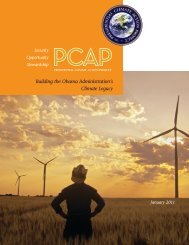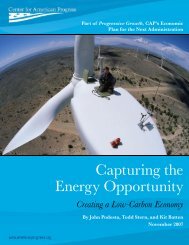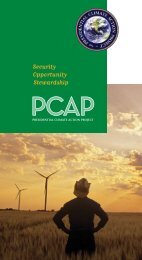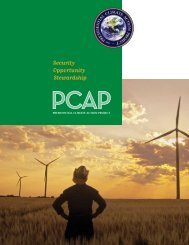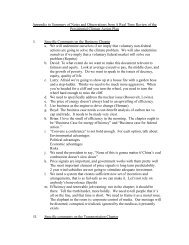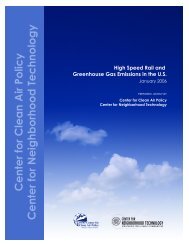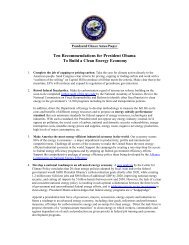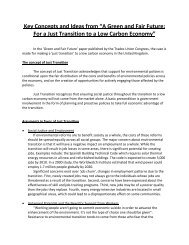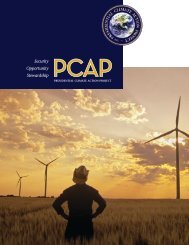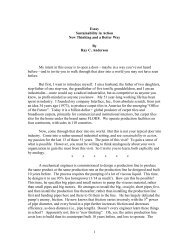PCAP - Presidential Climate Action Project
PCAP - Presidential Climate Action Project
PCAP - Presidential Climate Action Project
- No tags were found...
Create successful ePaper yourself
Turn your PDF publications into a flip-book with our unique Google optimized e-Paper software.
partnership is working to reduce methane emissions in four key sectors: agriculture (animalwaste management), coal mines, landfills, and oil and gas systems. The Partnership is led by theEnvironmental Protection Agency, working closely with the Department of State, theDepartment of Energy, and the United States Agency for International Development. 112The EPA launched the LMOP to encourage productive use of methane as part of the UnitedStates’ commitment to reduce greenhouse gas emissions under the UNFCCC. It is a voluntaryassistance and partnership program that promotes the use of landfill gas as a renewable, greenenergy source. The LMOP provides information, software tools, marketing assistance, andaccess to technical experts to facilitate development of landfill gas energy projects. 113Authority over the EPA. The EPA is neither an executive department nor an independentagency. In terms of the President’s authority over agencies, generally, the President’s authorityover the EPA would be much the same as an executive department. 114 In terms of this specificproposal, the President has the authority to direct the EPA to accelerate its efforts to the extentpermitted by law. 115 This authority will be further enhanced if the EPA determines that GHGsendanger public health or welfare under the CAA based on their impact on global climatechange, 116 considering: 1) the President’s constitutional authority as the person vested with thepower of the Executive Branch, duty to take care the laws be faithfully executed, and duty topreserve, protect and defend the Constitution including the purpose of promoting the generalwelfare; 117 2) the President’s substantial authority in planning energy and climate policy asestablished in Chapter II of this report; and 3) the science regarding climate change and GHGemissions.Executive Orders. There are numerous executive orders that direct agencies to proceedexpeditiously. For example, E.O. 13158 directs the EPA to begin rulemaking to address theprotection of beaches, coasts, and the marine environment from pollution and to expeditiouslypropose new regulations. 118 Further there are numerous executive orders that demandimmediacy. 119112 White House press release, available at http://www.whitehouse.gov/news/releases/2004/07/20040728-2.html113 Information about the LMOP is available at EPA’s Web site: http://www.epa.gov/lmop114 Boundaries Report, Chapter VI(1)(c).115 There are timelines set for certain activities under the Act. See Boundaries Report, Chapter VIII(1).116 See Proposal B-7.117 U.S. Const., Art. II, sects. 1, 3, and Art. I, forward.118 Exec. Order No. 13158, sec. 2(f), 65 Fed. Reg. 34, 909 (May 26, 2000); see also, e.g., Exec. Order Nos.: 13274(agencies shall to the maximum extent practicable expedite their reviews for relevant permits or other approvals, andtake related actions as necessary); 13212 (agencies shall expedite projects that will increase the production,transmission, or conservation of energy, expedite their review of permits or take other actions as necessary); 13139(expeditiously review waiver requests); 13101 (expedite the process of designating items that are or can be madewith recovered materials); 12333 (procedures required by this Order shall be established as expeditiously aspossible); 12153 (the Secretary shall expeditiously conduct a public inquiry as to what other types of heavy crudeoil, if any, should be exempted from price controls).119 E.g., Exec. Order Nos.: 13186 (agencies are encouraged to immediately begin implementing the conservationmeasures set forth above); 13271 (the Attorney General shall immediately establish within the Department of Justicea Corporate Fraud Task Force); 13103 (agencies are encouraged to immediately test and evaluate the principles andconcepts contained in the EPA’s guidance on the Acquisition of Environmentally Preferable Products).CEES 27 | P age



